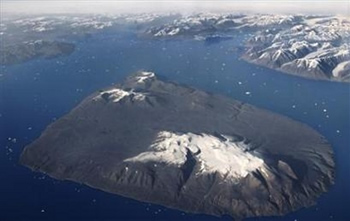Untitled Document
 |
|
Icebergs dot coastal waters on the shores of Greenland in this view taken from a commercial airliner flying at 37,000 feet on September 2, 2004. Rising temperatures trigger a runaway melt of Greenland's ice sheet, raising sea levels and drowning Pacific islands and cities from New York to Tokyo. (Andy Clark/Reuters)
|
Two of Greenland's largest glaciers are retreating at an alarming pace,
most likely because of climate warming, scientists said Wednesday. The other
glacier, Helheim, is retreating at about 7 miles a year — up from 4 miles
a year during the same period.
"It's quite a staggering rate of increase," Hamilton said
at the American Geophysical Union annual meeting.
Glaciers play a major role in discharging water into oceans. Sea levels have swelled
globally an estimated 4 inches to 8 inches during the past century due to melting
glaciers and polar ice — enough to cause some places to be awash at high
tide or during severe storms.
Melting of Greenland ice and calving of icebergs from glaciers is responsible
for about 7 percent of the annual rise in global sea level.
Global warming is frequently blamed for retreating glaciers around
the world. The rapid retreat of Greenland glaciers suggest that climate change
is a factor, Hamilton said.
Meanwhile, one of the fastest melting glaciers in North America has
reached the halfway point of disintegration and will continue retreat for another
two decades.
Alaska's Columbia Glacier — about the size of Los Angeles — has
shrunk 9 miles since the 1980s. It is expected to lose an additional 9 miles
in the next 15 to 20 years before the bed of the glacier rises above sea level.
The glacier, which moves about 80 feet a day, currently releases about 2 cubic
miles of ice every year into the Prince William Sound on the south coast of
Alaska.
Understanding what happens during Alaskan glacier retreat could help explain
the phenomenon in Greenland, said Tad Pfeffer, associate director of the University
of Colorado's Institute of Arctic and Alpine.
Pfeffer said climate change warming trends do not directly explain the shrinking
Columbia Glacier and other tidewater glaciers. Instead, scientists think the
retreat is triggered by a slow warming trend that began five centuries ago.
Significant thinning of the Columbia Glacier is thought to be caused by huge
chunks of iceberg that break off into the sound as a result of seawater pressure
rather than climate change, Pfeffer said.
The glacier, which is up to 3,000 feet thick, has thinned up to 1,300 feet
in some places in the last two decades.

